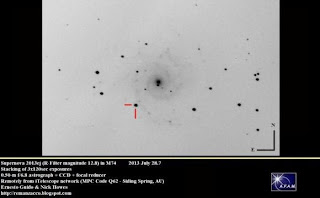I love this galaxy. Not only does M74 display a near perfect spiral form but if this latest supernova is the third to “go boom” in the galaxy in just 11 years. The new object, designated PSN J01364816+1545310, was discovered blazing near 12.4 magnitude by the Lick Observatory Supernova Search at Lick Observatory near San Jose, Calif. “PSN” stands for “possible supernova” and the long string of numbers give the object’s position in the sky using the celestial equivalents of latitude and longitude.
Update: The supernova has now been confirmed, and is now officially named SN 2013ej.
Supernova 2013ej, taken remotely on July 29, 2013 from iTelescope Network using the Siding Spring Observatory. Credit: Ernesto Guido and Nick Howes.
Supernova 2013ej, taken remotely on July 29, 2013 from iTelescope Network using the Siding Spring Observatory. Credit: Ernesto Guido and Nick Howes/Remanzacco Observatory.
Additional information and imagery of this from the Remanzacco Observatory team can be found at their website, including an animation of a “before and after” the supernova exploded.
M74 is a classic spiral galaxy with arms that appear to unwind from a bright, star-packed nucleus. Located 32 million light years away in the constellation Pisces, M74 contains about 100 billion stars. The spiral arms are dotted with dense star clusters and pink clouds of fluorescing hydrogen gas. Credit: Jim Misti
M74 is a classic spiral galaxy with arms that appear to unwind from a bright, star-packed nucleus. Located 32 million light years away in the constellation Pisces, M74 contains about 100 billion stars. The spiral arms are dotted with dense star clusters and pink clouds of fluorescing hydrogen gas. Credit: Jim Misti
The Lick search uses a fully robotic or automated 30-inch (76 cm) telescope dedicated to scanning the skies for new supernovae. It nailed M74′s latest exploding star on July 25. Two previous supernovae flared in the galaxy - SN 2002ap and SN 2003gd - and rose to 12th and 13th magnitude respectively before fading away into obscurity.

No comments:
Post a Comment